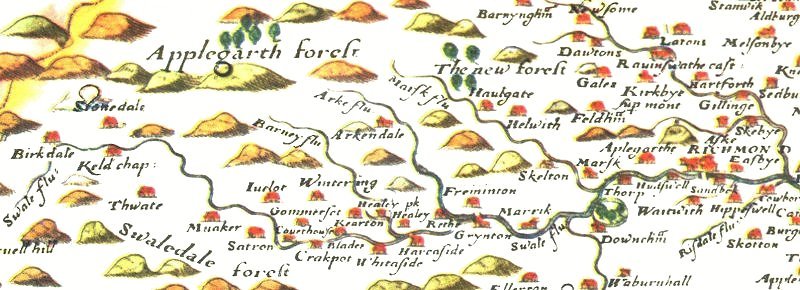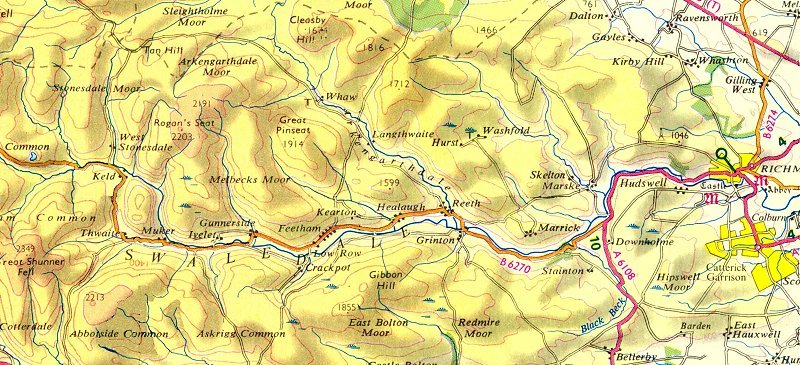This set of essays is about Swaledale's people and communities, and the inevitable move to the cities at the end of the 19th century. You can find details about each essay on the Contents page.
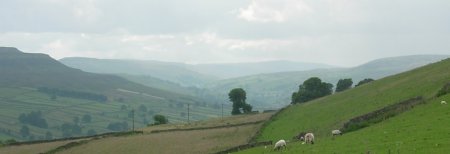
Swaledale is the most northerly of the Yorkshire Dales. It became my mother's favourite in all her years of walking the dales whilst I was busy living a life a long way from Yorkshire. Many years later my husband John, who had been digging over our family histories for some years, suggested that I have a good look at my great-great-grandfather James Spenceley, born about 1800 at Feetham Holme in Swaledale. I found James, but I also found sources and resources for a way of living very different from my own, and that interested me greatly.
In this 2012 revision of my earlier stories, James and his family do keep popping up - his third wife (and my gt-gt-grandmother) was a Metcalfe, which makes it inevitable, but in 2007 what I really wanted to do was to analyse a small, isolated community, to see how self-sufficient it might have been. I soon realised that even small isolated communities have wider links, but it was a start. From Feetham Holme, I decided to go datagathering upstream to Birkdale and downstream to Marrick, where the dale widens and meanders on towards Richmond. The censuses taken between 1841 and 1901 gave me a database of over 35,000 people. That should be enough, I thought.
Please will any Arkengarthdalers (and Birkdalers and Stonesdalers) forgive me if from now on I use "Swaledale" to mean "Swaledale and Arkengarthdale and Birkdale and Stonesdale"?
The database shows everyone who was in the dale on each census night between 1841 and 1901, in Swaledale (from Birkdale to Marrick) and in Arkengarthdale. With her agreement, I had started with Christine Amsden's census transcripts (see Useful Links below). Then I added notes, calculated everyone's date of birth, and made them easy to search and sort. I also lodged an electronic copy of the files with the Swaledale Museum in Reeth, as the ultimate backup. If you would like your own copies of these Excel files, please use the link to send me an email. I had no idea what I was getting into.
The Swaledale home page lists my essays, based directly or indirectly on that census data but with the occasional drilldown into individual families and events. In 2008 I added information from 19thC newspapers and other publicly-available sources. In recent years correspondents have corrected my mistakes, or sent me new information to add. This kind of research never stops.
19thC industry - mining and dressmaking
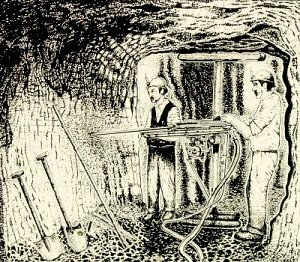
This sketch of 1880s leadminers is from the Snailbeach Lead Mine museum in Shropshire.

Much of the industry in Swaledale started long before the censuses were taken. By 1841, the hosiery trade was almost gone, though hand-knitting was still an occasional occupation. Lead mining had also peaked some time before and by the end of the century cheap lead was being imported and profits had really dropped. So by 1841, although lead mining was still the major industry of the dale, everything was now in decline, and - apart from a brief and unsuccessful new lead mine in the 1880s - the decline accelerated as the decades went by and the population fell, and fell.
In 1851, Swaledale and Arkengarthdale had a population of 6,835 of which 1124 were lead miners. By 1891, this had dropped by more than half to a population of 3,250 and 258 miners.
Population:
1851: 6,385
1891: 3,250
I analysed the census data to see what was happening. Every district had at least three dressmakers and bootmakers but there was only one pharmacist in the whole dale. The only vet lived in Reeth. The only doctors were in Reeth or Gunnerside. There was a miller in most districts but only one baker in Reeth - everyone else must have made their own bread.
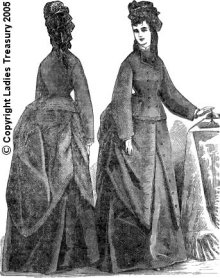
To begin with, I used "dressmakers" in the title here simply as a contrast to lead miners, and also because I have been one myself, part time, for many years (alongside teacher and technical author and grandmother).
But until I thought about it a bit more I was astonished to find that, after lead mining, dressmaking was the next most common occupation (if you don't count domestic service).
Here are some smart 1870s clothes. No doubt the milliner, staymaker and mantua-maker (an early description for simple dressmaking) were involved too. And the cordwainer. But, as I found, the lady would have had to go to Richmond for her gloves.
I have not attempted to write in detail about lead mining, or the Dales in general. These subjects are already well researched and described elsewhere (see the Useful Links below). But I hope this introduction has prompted you to find out more about Swaledale in the 19th century. Please click here to go back to the Swaledale home page and Contents.
In the useful sources I list below, by far the most helpful and interesting is that of the Upper Dales Family History Group. Although based in the Upper Dales, with a year-round programme of events and speakers, the UDFHG offers an email Forum to a world-wide membership. This members-only Forum is busy, active, inquisitive, courteous, and very helpful. If you have any personal connections to Swaledale or Wensleydale, do give them a try.
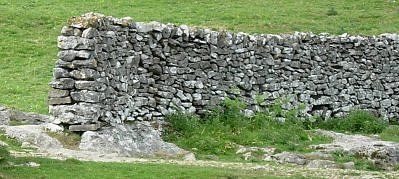
Maps of Swaledale
Here is what the dale looked like in 1577, when Saxton published his magnificent map of Yorkshire.
Move the cursor over the map to see an enlarged version ... thanks to Scott Kimler of randsco.com for the clever zoom code.
And here is a modern map of the dale showing the main village names. It is interesting to compare it with the Saxton map and see which names no longer appear, although the places still exist. Winterings, Satron, Harcaside, Whitaside, Healey (Healaugh?) Park, were all much more important in Saxton's time.
Move the cursor over the map to see an enlarged version ... thanks to Scott Kimler of randsco.com for the clever zoom code.
Here are some other sources of maps that you might find helpful:
- The Grinton map pages on Genuki show many of the places named in the censuses, so I do not replicate them here. Many of the names used in the census returns do not appear in all censuses. This may be due to the enumerator, or to changes in names, or to new build or disuse. For my own information I wrote a summary of all the places and houses named in the various censuses and checked to see when they appeared and disappeared. Contact me if you are interested and I will send the list to you as an Excel file.
- Some large-scale old maps are available on the internet and these show places not on newer maps.
- The modern Philip's Street Atlas for North Yorkshire (extremely useful when driving around) shows some individual place names, as does the Ordnance Survey Yorkshire Dales map, but only those still in use today.
- Ordnance Survey 6" maps show great detail. If you can find old ones you have the best chance of finding individual houses and tiny hamlets.
- David & Charles have a reprint of the first edition (around 1860) of the 1" OS map of Richmond area, which covers Swaledale, but unfortunately the dramatic engraving lines obscure much of the small print.
- A stunning satellite photograph of Swaledale is instantly available if you have access to Google maps. Just zoom in on the north of England, find Richmond then drag the map west until you can see the whole dale.
- And on a very different scale, here is a website that offers plans of all the Dales villages and their houses, as they are today.
Useful websites and books
- Upper Dales family history group (a new URL in 2018), a goldmine of archived information, obscure links and helpful emailers
- Christine Amsden's original Swaledale and Wensleydale census transcripts
- and her main website
- the Gunnerside website which provides a very useful resource for family historians, including biographies, and transcripts of wills and letters
- the Grinton village website which contains an interesting history section, memorial inscriptions from Grinton parish church, and some beautiful photographs
- freebmd, which is the fastest (and free) way to search for English BMD records after 1837
- Swaledale lead mines
- The Swaledale Museum in Reeth
- Yorkshire Dales National Park Authority page
- GENUKIís Yorkshire home page
- A Vision of Britain - collection of government and academic statistical reports; drill down to see historical data and analysis about individual towns
- a website in Swaledale, with webcam, weather station, and some lovely old photographs
- For guidance in dating old photographs, try Roger Vaughan's Victorian and Edwardian photographs
- For excellent on-line (and free) access to searchable old English trade and Post Office directories, try Leicester University's historical directories site.
- If you are interested in other Yorkshire stories, or HEARFIELDs, or how windmills work, click here
and here are some of the useful and interesting books I have found:
- Mining and Miners in 19th century Swaledale and Arkengarthdale by Alan Mills, a book available through the Upper Swaledale FHS which describes wages and mortality rates as well as the lead mining process itself.
- Life and Tradition in the Yorkshire Dales and A Dales Heritage, by the awesome Marie Hartley and Joan Ingilby, each contain many old photographs of people with familiar names, and placenames, and stories about farmers and craftsmen and horsefairs and baking and mining, all done by families who will be well-known to anyone with Dalesfolk as their ancestors.
- Life behind the cottage door by Valerie Porter, pub 1992, Whittet Books
- A Victorian Poacher, James Hawker's Journal ed Garth Christian, pub 1961, Oxford University Press
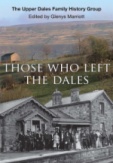
Those who Left the Dales - our own UDFHG book
In October 2010 the Upper Dales Family History Group celebrated its 10th anniversary with a large exhibition, at which was launched a book containing over one hundred stories of migration from Swaledale and Wensleydale, all contributed by members, and published by the UDFHG.
I wrote the index for this book so I had a preview. For anyone with family names from these dales the stories are moving or funny or astonishing and all are remarkable. Highlights of the exhibition, and full details of the book and how to buy a copy, are given on the editor's own website at Cumpston Research. Just click on the link.


